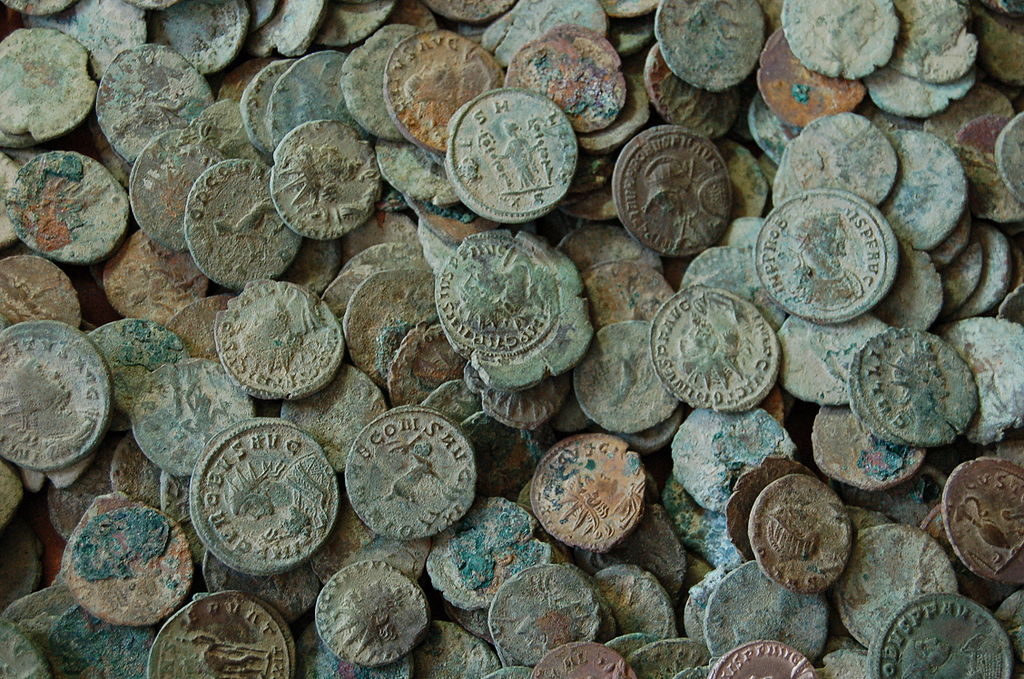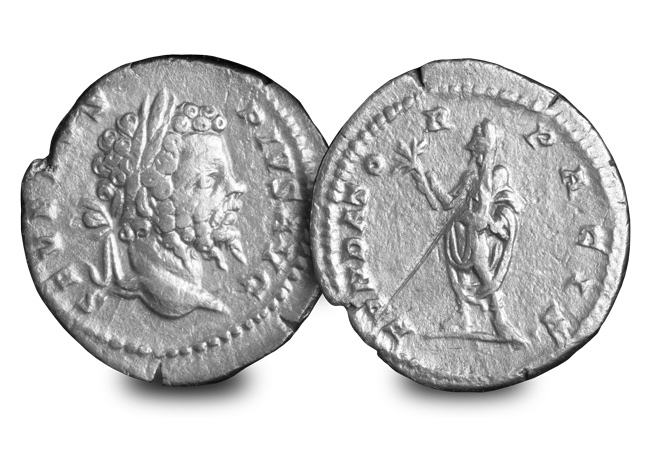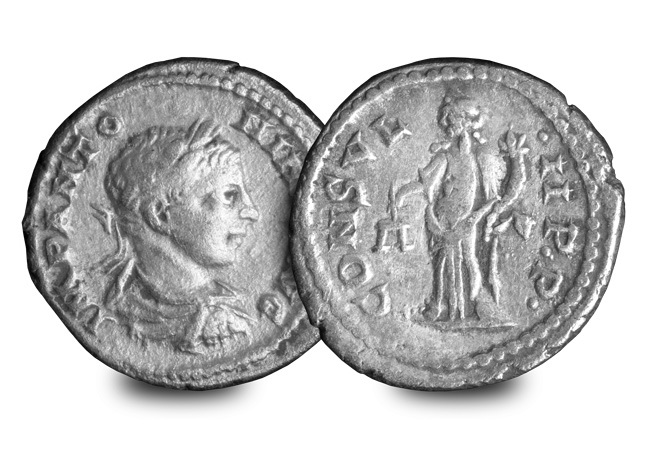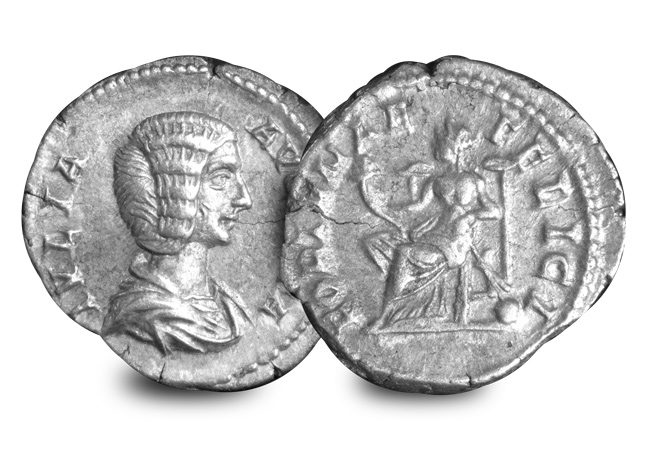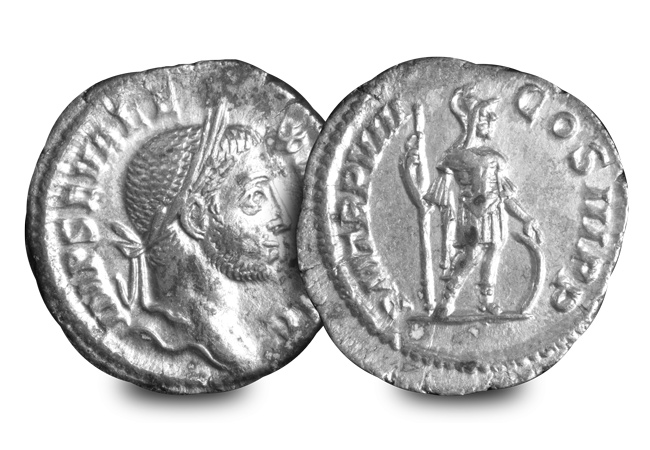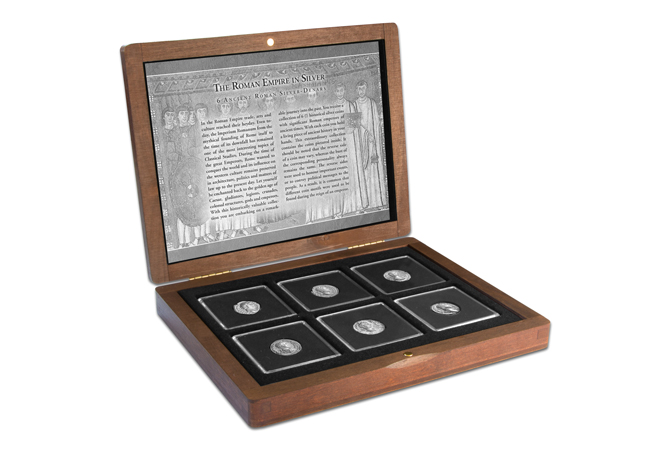Posts Tagged ‘Roman Coins’
Hidden treasure – five fascinating discoveries…
I guess for any coin collector – certainly metal detectorists, the excitement of uncovering hidden treasures are what dreams are made of.
That was certainly the case for these five discoveries – from losing a hammer and finding a hoard of Roman coins, to uncovering sunken treasure in Israel. Each of these findings are incredible…
- The Hoxne Hoard
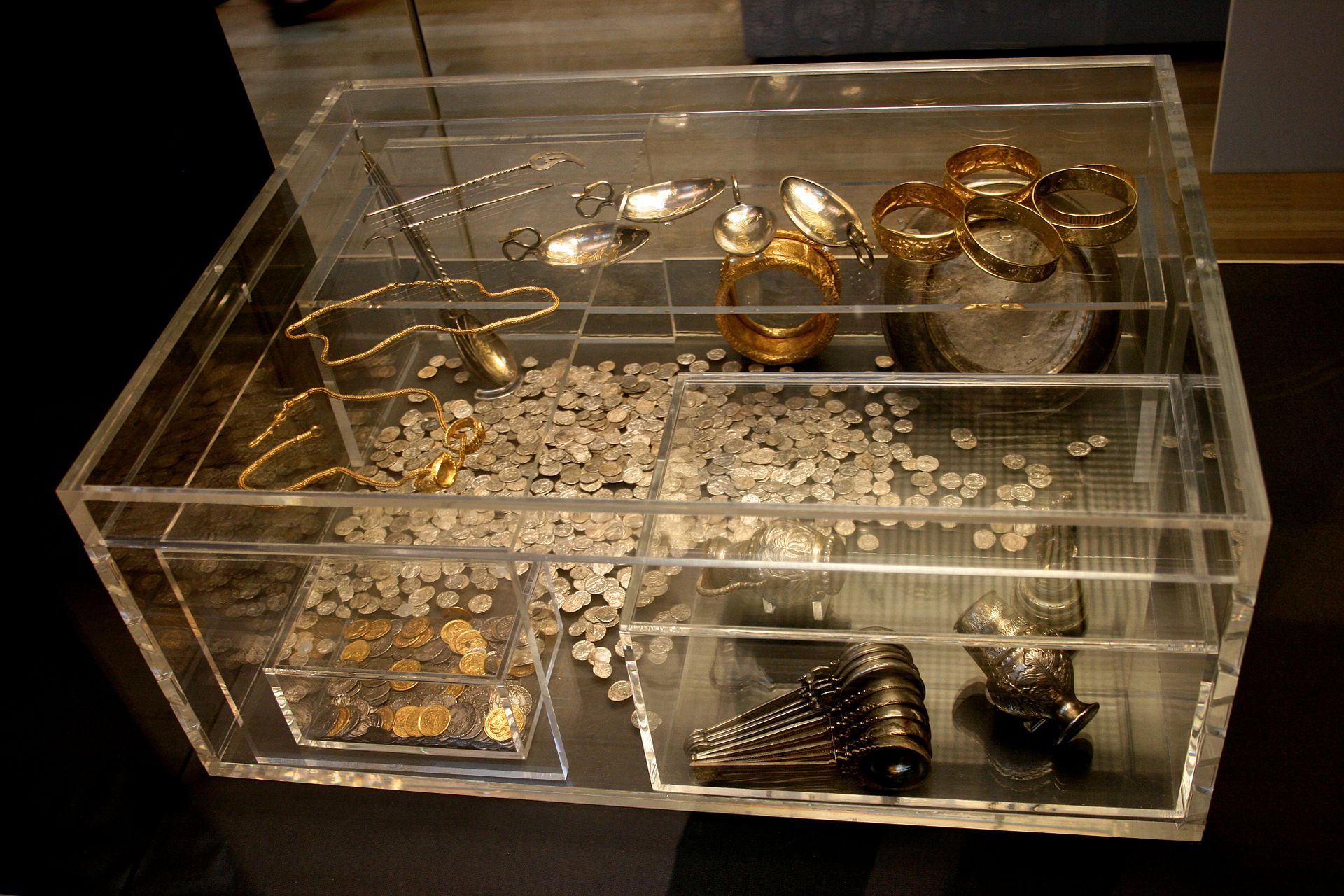
Hoxne Hoard: Display case at the British Museum showing a reconstruction of the arrangement of the hoard treasure when excavated in 1992.
Photograph by Mike Peel (www.mikepeel.net).
The Hoxne Hoard is the largest hoard of late 4th century Roman silver and gold ever discovered in the United Kingdom.
The hoard of treasure was discovered on November 16th, 1992. Farmer Peter Whatling, from the village of Horne in Suffolk, had lost his hammer in his field and had asked his friend, a retired gardener and amateur metal detectorist to help him look for it. While searching the field Lawes discovered silver spoons, gold jewellery and numerous gold and silver coins.
Upon alerting landowners and the local police, a team of archaeologists from the Suffolk Archaeological Unit carried out an emergency excavation of the site and discovered 14,865 Roman gold, silver and bronze coins from the late fourth and early fifth centuries along with approximately 200 items of silver tableware and gold jewellery.
The objects are now in the British Museum in London and are said to be worth around £3.1 million. As for the errant hammer? That’s now in the British Museum, too!
- The Staffordshire Hoard.
In July, 2009, Terry Herbert was using his metal detector on a recently ploughed field in Staffordshire when he discovered the largest trove of Anglo-Saxon treasure ever found.
Over 3,500 military items were discovered including weaponry items as well as several religious artifacts and decorative items. It is said that the hoard dates back to the 8th century and has influenced the way historians think about that period in English history.
Valued at approximately £3.3 million, it has since been purchased by the Birmingham Museum & Art Gallery and the Potteries Museum & Art Gallery.
- Caesarea Sunken Treasure
In 2015 a group of Scuba divers were exploring the sea bed near the harbour of Caesarea National Park, Israel. They thought they had stumbled across a child’s toy when they found the first gold coin, but when they saw how many more there were and looked more closely at the engravings on them, they realised they had in fact discovered something a lot more significant.
Almost 2,000 coins were recovered, all of several different denominations and had been minted at different times. The earliest coin found in the treasure was a quarter dinar minted in Palermo, Sicily in the second half of the ninth century CE. Most of the coins though belong to the Fatimid caliphs Al-Ḥākim (996–1021 CE) and his son Al-Ẓāhir (1021–1036), and were minted in Egypt and North Africa.
The exact value of the coins today is still unknown.
- Harrogate Hoard
In January 2007, semi-retired businessman David Whelan and his son Andrew discovered the Harrogate hoard using metal detectors near the town of Harrogate in North Yorkshire.
It was the largest Viking hoard discovered in Britain since 1840 and consists of 617 silver coins and 65 other items, including ornaments, ingots and precious metal – all of which was hidden in a gilt silver vessel lined with gold which was made in France or Germany around 900.
The coins date from the 10th Century and come from all over Anglo-Saxon England, as well as parts of Asia. Reports indicate that the coins bear Islamic, Christian, and pre-Christian Norse pagan symbols.
The independent Treasure Valuation Committee valued the hoard at £1,082,000. The hoard was purchased jointly by the York Museums Trust and the British Museum.
- The Frome Hoard
In April 2010, metal detectorist Dave Crisp discovered 52,503 Roman coins near Frome in Somerset.
The coins were contained within a ceramic pot and date from AD 253 to 305. Most of the coins are made from debased silver of bronze and was the equivalent of four years of pay for a Roman legionary.
Weighing 350 pounds, the coins may have been buried as an offering for a good harvest or auspicious weather.
The hoard is one of the largest ever found in Britain, and is also important as it contains the largest group ever found of coins issued during the reign of Carausius, who ruled Britain independently from 286 to 293 and was the first Roman emperor to strike coins in Britain.
The hoard could fetch at least £250,000 today.
Have you ever discovered any hidden treasures? Let us know in the comments below…
You can now own your own treasure chest containing 1kg of mixed coins, medals and tokens from all around the world.
Each ‘mystery mix’ is completely different – who knows what you may find in yours…
The coins behind 6 of the greatest Roman Emperors
One of the first actions of any new Roman Emperor was to strike coins bearing their image. Distributed to the far corners of the empire, coins acted as propaganda and legitimised the rule of new emperor, whether they gained power through means fair or foul.
Each of the emperors of ancient Rome has a story. Some are remembered for being strong, some were crazy and some completely despised. I’ve put together a list of 6 of the most significant rulers in the history of ancient Rome alongside one of their coins…
Antoninus Pius
Often referred to as the “calm before the storm”, Antonius Pius enjoyed a long reign. His reign was considered the last extended period of peace prior to his adopted son Marcus Aurelius, coming to power on the day of his death. Antonius Pius was considered modest, austere and well-educated and his reign was characterized by peace and economic recovery, he died a very popular man.
Septimius Severus
The founder of the Severus dynasty, Septimius Severus enjoyed an extensive education and spoke several languages. He was proclaimed emperor by his troops after the violent death of his predecessor and managed to rule unchallenged for 18 years. It is thought that the decline of the Roman Empire began with Severus. Following his death in Britain he was exalted to the level of a God by the Senate.
Caracalla
Caracalla succeeded as Roman Emperor following the death of his father Septimius Severus, however he had already been elevated to the position of co-ruler as early as the year 197. Caracalla and his brother Geta had initially reigned jointly, however Caracalla arranged for his brother and all his brothers followers to be murdered, assuming sole regency over the empire. It’s fair to say that Caracalla was not a popular ruler among Rome and while on a pilgrimage he was murdered in an ambush by his own soldiers ending his forceful reign.
Julia Domna
Julia Domna was the second wife of Septimius Severus and mother to two sons, Caracalla and Geta. She accompanied her husband on his campaigns in the east of the Empire and was very much respected, the indication being that her portrait featured on coins. However it wasn’t all plain sailing and she suffered greatly due to the strife between her two sons. She lived to witness Caracalla murder his brother Geta, the same year her husband died. Following her own death, she was also elevated to the rank of the Gods.
Elagabalus
The reign of Elagabalus was scandalous to say the least. When his cousin Caracalla was murdered, his mother passed him off as Caracalla’s illegitimate son, winning the support of the nearby soldiers. His original name was Varius Avitus Bassianus but became generally known as Elagabalus because of his earlier role as a priest of the sun God of that name. Just like his predecessor, Elagabalus too suffered a violent death. He was slain by his own guards along with his mother and thrown into the Tiber when the false claims of his legitimacy came to light.
Alexander Severus
Alexander Severus was appointed Emperor at the tender age of 13 but the dominant ruler was actually his mother, Julia Mamaea. She saw to it that her son received a good education but deprived him of any powers. Gradually the lack of an emperor’s presence in the army dwindled and he too was faced with a violent demise. Eventually, Alexander and his mother were murdered by mutinous soldiers serving under Maximus Thrax, the self-proclaimed new emperor. With the death of both mother and son, the Severus dynasty ceased and the era of soldier-emperors commenced.
It’s hard to imagine living in a time as brutal as the stories behind these Emperors of ancient Rome. The golden age of Caesar, gladiators, legions and colossal structures.
Now you have the chance to embark on a remarkable journey into the past with this collection of 6 historical silver coins. Nothing can bring to life history like coins from time gone by and with each coin, you can hold a living piece of ancient history in your hands.
How far would you go to guard your coin collection?
Devon man Laurence Egerton decided to camp outside for THREE DAYS to protect his coins from potential thieves – however, he had just discovered the third largest hoard of Roman coins ever uncovered in the UK.
Almost 22,000 Roman coins from the reign of Emperor Constantine were discovered by the amateur metal detectorist in Seaton, East Devon. Now called the ‘Seaton Down Hoard’, it was declared treasure at a Devon Coroner’s inquest on Friday 12th September 2014.
His discovery is one of the biggest hoards of 4th century Roman coins to ever be recorded in Britain – after the Frome Hoard of 52,503 found in 2010, and 22,703 coins found in Dorset in 1989.
The copper alloy coins also happen to be one of the best preserved 4th century collections to have been excavated.
The asking price for the hoard will be decided by the British Museum’s Treasure Valuation Committee later this year, but it just goes to show, there could even be a Roman hoard in your back garden!
Roman Coin Offer
If you want to add a Roman coin to your collection right now, click here to secure a genuine issue from the reign of Claudius II Gothicus.




